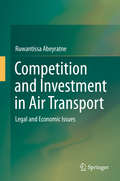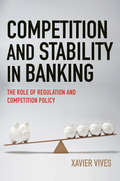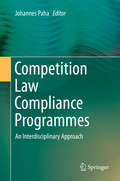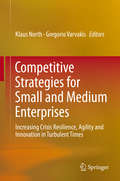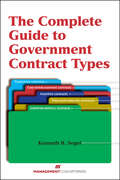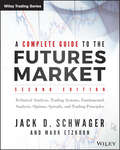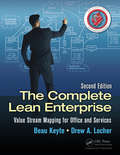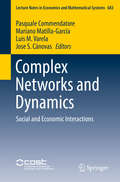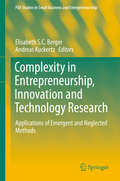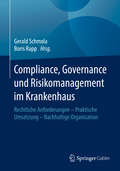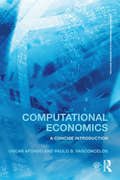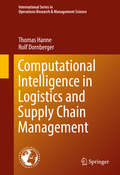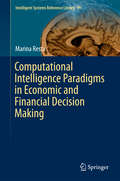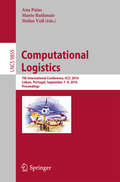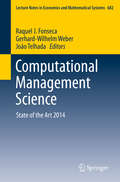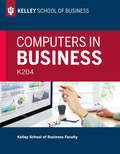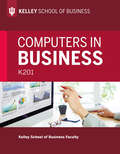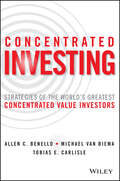- Table View
- List View
Competition and Investment in Air Transport: Legal and Economic Issues
by Ruwantissa AbeyratneThis book addresses emerging legal and economic issues in competition and investment in air transport, against the backdrop of the role governments and airlines should play in avoiding protectionism and encouraging innovation and creativity. It evaluates current trends in air transport and the direction the industry is taking in the twenty first century. There are discussions on key aspects of air transport, such as safety assurance and environmental protection, as they are impacted by competition. The rapid evolution of aerospace transport and its effect on competition in air transport is also examined. A recurring theme of the book is the influence of creative destruction and disruptive innovation on air transport. This is addressed through an in-depth study of the contentious areas of law relating to the abuse of dominant positions and state aid, as reflected in the ongoing claim by the three largest US carriers against Gulf carriers such as Emirates Airlines, Etihad and Qatar Airways. The US carriers claim that Emirates and Etihad - which operate air services into the United States by virtue of an open-skies agreement between the US and The United Arab Emirates - are using generous subsidies given to them by their g overnments to illegally capture the "legitimate" market belonging to the US carriers. These issues are clarified in the book using analyses of competition law and investment law as they apply to air transport, free-trade-agreement analogies and an open-skies case study.
Competition and Stability in Banking: The Role of Regulation and Competition Policy
by Xavier VivesDoes too much competition in banking hurt society? What policies can best protect and stabilize banking without stifling it? Institutional responses to such questions have evolved over time, from interventionist regulatory control after the Great Depression to the liberalization policies that started in the United States in the 1970s. The global financial crisis of 2007-2009, which originated from an oversupply of credit, once again raised questions about excessive banking competition and what should be done about it. Competition and Stability in Banking addresses the critical relationships between competition, regulation, and stability, and the implications of coordinating banking regulations with competition policies.Xavier Vives argues that while competition is not responsible for fragility in banking, there are trade-offs between competition and stability. Well-designed regulations would alleviate these trade-offs but not eliminate them, and the specificity of competition in banking should be accounted for. Vives argues that regulation and competition policy should be coordinated, with tighter prudential requirements in more competitive situations, but he also shows that supervisory and competition authorities should stand separate from each other, each pursuing its own objective. Vives reviews the theory and empirics of banking competition, drawing on up-to-date analysis that incorporates the characteristics of modern market-based banking, and he looks at regulation, competition policies, and crisis interventions in Europe and the United States, as well as in emerging economies. Focusing on why banking competition policies are necessary, Competition and Stability in Banking examines regulation's impact on the industry's efficiency and effectiveness.
Competition Law Compliance Programmes: An Interdisciplinary Approach
by Johannes PahaThis book reviews and presents antitrust law compliance programmes from different angles. These programmes have been increasingly implemented and refined by firms over recent years, and various aspects of this topic have been researched. The contributions in this book extend beyond the treatment of legal issues and show how lawyers, economists, psychologists, and business scholars can help design antitrust law compliance programmes more effectively and run them more efficiently.
Competition Policy Enforcement in EU Member States: What is Independence for? (European Administrative Governance)
by Mattia GuidiThis book investigates the crucial EU policy of competition, which is enforced by the Commission and by national agencies that enjoy various degrees of autonomy from their governments. More and more policy-making activities are nowadays delegated to agencies that cannot be held accountable to parliaments, and ultimately to voters. The author explains why this is the case in the field of EU competition policy and discusses whether independence is linked to improved enforcement - as theories of delegation and common wisdom would suggest. These questions are explored with an in-depth analysis covering 27 EU countries for 17 years (1993-2009). While the results show that independence is given when countries lack credibility and good reputation, they also point out that autonomy from governments can hardly be associated with improved regulatory output. So, is independence of competition authorities useful to society in the end? This book will appeal to upper-level students and scholars interested in competition policy, regulatory agencies, and European public policy.
Competitive Strategies for Small and Medium Enterprises: Increasing Crisis Resilience, Agility and Innovation in Turbulent Times
by Klaus North Gregorio VarvakisThis bookis a timely guide for Small and Medium Enterprise (SME) researchers, policymakers and strategists. SMEs are the most important sources of job creation andlocal development especially in knowledge-based economies. As turbulence in theglobalized economies expands SMEs will have to learn to sustain competitivenessby developing their 'dynamic capabilities'. Based on the findings of a 4-yearEuropean and Latin American research project, this book provides a theoreticalframework, practical instruments and cases on how SMEs in diverse economic,social and cultural contexts can develop crisis resilience, increase agility,innovate and thus successfully compete in turbulent times.
Competitiveness of CEE Economies and Businesses: Multidisciplinary Perspectives on Challenges and Opportunities
by Piotr Trąpczyński Łukasz Puślecki Mirosław JarosińskiThis book presents peer-reviewed, state-of-the-art conceptual and empirical papers devoted to changes in the international competitive position of the Central and Eastern European (CEE) region, its countries and businesses. While the unprecedented scale of transformation in the CEE region has provided a distinct research setting for international business and economics scholars for more than two decades, there have also been recent discussions about the extent to which the region continues to have a unique business environment. The region's economies have reached different levels of market development and modern business practice adoption, with some of them now frequently classified as advanced economies. Consequently, the same level of heterogeneity among CEE countries can also be observed at the sector and business level. The contributions in this book highlight possible sources of competitive advantage for CEE countries and firms, in light of recent intensive debates about the danger of the middle-income trap and the potential solutions to it.
Competitiveness, Social Inclusion and Sustainability in a Diverse European Union: Perspectives from Old and New Member States
by Peter Huber Danuše Nerudová Petr RozmahelThis book brings together the work of researchers in Eastern and Western Europe, who analyze competitiveness, social exclusion and sustainability from a range of perspectives. It examines the key challenges faced by the EU in its efforts to establish a socially inclusive and greener path to growth and develops policy recommendations to simultaneously achieve the EU 2020 agenda's long-term goals and address the current economic crisis in Europe.
The Complete Guide to Government Contract Types
by Kenneth R. SegelEverything You Need to Know About Government Contract TypesAs the world's single largest buyer of goods and services, the federal government has many ways to structure its procurements. Different situations and conditions often determine the best vehicle for a particular purchase. Contracting officers must assess a wide range of factors to determine which contract type will provide the government the best value and the least risk.The Complete Guide to Government Contract Types provides a comprehensive overview of the key government contract vehicles and types: fixed-price, cost-reimbursement, incentive, and other (which includes letter, indefinite-delivery/indefinite-quantity, and time-and-material contracts). The author first explains the selection process for contract vehicles, which is the basis for selecting the appropriate contract type for the work in question. He then presents a comprehensive, in-depth analysis of each contract type, explaining how each works best to meet certain types of requirements and conditions.This is an essential resource for both contracting officers and contractors seeking to understand and work effectively within the nuances of contract selection and compliance.
A Complete Guide to the Futures Market: Technical Analysis, Trading Systems, Fundamental Analysis, Options, Spreads, and Trading Principles
by Jack D. Schwager Mark EtzkornThe essential futures market reference guide A Complete Guide to the Futures Market is the comprehensive resource for futures traders and analysts. Spanning everything from technical analysis, trading systems, and fundamental analysis to options, spreads, and practical trading principles, A Complete Guide is required reading for any trader or investor who wants to successfully navigate the futures market. Clear, concise, and to the point, this fully revised and updated second edition provides a solid foundation in futures market basics, details key analysis and forecasting techniques, explores advanced trading concepts, and illustrates the practical application of these ideas with hundreds of market examples. A Complete Guide to the Futures Market: Details different trading and analytical approaches, including chart analysis, technical indicators and trading systems, regression analysis, and fundamental market models. Separates misleading market myths from reality. Gives step-by-step instruction for developing and testing original trading ideas and systems. Illustrates a wide range of option strategies, and explains the trading implications of each. Details a wealth of practical trading guidelines and market insights from a recognized trading authority. Trading futures without a firm grasp of this market’s realities and nuances is a recipe for losing money. A Complete Guide to the Futures Market offers serious traders and investors the tools to keep themselves on the right side of the ledger.
The Complete Lean Enterprise: Value Stream Mapping for Office and Services, Second Edition
by Beau Keyte Drew A. LocherThe first edition of this book won a Shingo Prize for Excellence in Manufacturing Research, and now, following in the tradition of its bestselling predecessor, The Complete Lean Enterprise: Value Stream Mapping for Office and Services, Second Edition details a robust step-by-step approach for implementing Lean initiatives in the service industry and office environments.A must-read for those looking to maximize the value they provide their customers, this new edition describes how to better align value stream improvements to strategic needs. In addition, it engages the entire organization in experimentation and connects a new management system with tiered visuals in support of leader standard work.This updated edition of a Shingo Prize Winner: Features new critical steps in planning and preparing for VSM events Includes new content and examples from the service industry, including healthcare Provides a new examination of future state mapping Details methods for engaging an entire organization in continuous improvement by focusing on socialization Discusses the use of experiments to "learn your way" to a future state Provides examples of tiered visual management and demonstrates the principles of a lean management system Providing improved ways to involve your organization in transformation and to sustain your efforts, the book expands beyond the "tools focus" to challenge your organization to think and act differently in order to change the culture of your organization as you become more effective and efficient.
Complex Networks and Dynamics: Social and Economic Interactions (Lecture Notes in Economics and Mathematical Systems #683)
by Pasquale Commendatore Mariano Matilla-García Luis M. Varela Jose S. CánovasThis volume sheds light on the current state of complex networks and nonlinear dynamics applied to the understanding of economic and social phenomena ranging from geographical economics to macroeconomics and finance, and its purpose is to give readers an overview of several interesting topics for research at an intermediate level. Three different and interdisciplinary, but complementary, aspects of networks are put together in a single piece, namely: (i) complex networks theory, (ii) applied network analysis to social and economic interrelations, and (iii) dynamical evolution of systems and networks. The volume includes contributions from excellent scholars in economics and social sciences as well as leading experts in the fields of complex networks and nonlinear dynamics.
Complexity in Entrepreneurship, Innovation and Technology Research: Applications of Emergent and Neglected Methods (FGF Studies in Small Business and Entrepreneurship)
by Andreas Kuckertz Elisabeth S.C. BergerThisvolume discusses the challenge of dealing with complexity in entrepreneurship,innovation and technology research. Businesses as well as entire economies areincreasingly being confronted by widespread complex systems. Fields such asentrepreneurship and innovation cannot ignore this reality, especially withtheir inherent links to diverse research fields and interdisciplinary methods. However, most methods that allow more detailed analyses of complex problems areeither neglected in mainstream research or are, at best, still emerging. Against this backdrop, this book provides a forum for the discussion ofemergent and neglected methods in the context of complexity inentrepreneurship, innovation and technology research, and also acts as aninspiration for academics across related disciplines to engage more incomplexity research.
The Complexity of Tax Simplification: Experiences from Around the World
by Simon James Adrian Sawyer Tamer BudakThe Complexity of Tax Simplification: Experiences from Around the World by Simon James, Adrian Sawyer, Tamer Budak.
The Complexity of Workplace Humour
by Barbara PlesterThis book discusses boundaries for organizational humour as well as the jokers and jesters that enliven modern workplaces. It has long been accepted that humour and tragedy can occupy the same space and that is eloquently demonstrated in this book. Using ethnographic research techniques, a selection of stories, ruminations, cartoons, and narratives of events is combined with theoretical conceptions of humour and fun to create a comprehensive analysis of the good, the bad, and the downright ugly in organizational humour.
Compliance, Governance und Risikomanagement im Krankenhaus: Rechtliche Anforderungen – Praktische Umsetzung – Nachhaltige Organisation
by Gerald Schmola Boris RappDer Herausgeberband stellt die rechtlichen Anforderungen umfassend dar, liefert praktische Beispiele und gibt Handlungsempfehlungen zur frühzeitigen Erkennung von Fehlverhalten und Risiken im Krankenhaus, deren Rechtsfolgen und künftigen Vermeidung. Compliance meint hierbei das Einhalten interner wie externer Vorgaben und Normen sowohl im Hinblick auf die Patientenversorgung und die Abrechnung der erbrachten Leistungen als auch die Beziehungsgeflechte mit Lieferanten und Dienstleistern. Durch Governance-Strukturen ist dieses System in eine auf die Unternehmensführung ausgelegte Richtlinien- und Gremienstruktur eingebettet, zu der auch die Festlegung von Unternehmenszielen und der Weg der Zielerreichung zählen. Das Risikomanagement wiederum beschreibt den Umgang mit bekannten und unbekannten Risiken durch definierte Abläufe, die frühzeitig einsetzen und Strategien zur Risikominimierung und dem Umgang mit potenziellen Schäden umfassen. Alle drei Handlungsfelder sind aufgrund zahlreicher rechtlicher Bezüge und einer im Krankenhausbereich recht jungen Auseinandersetzung damit vielfach noch gar nicht bekannt bzw. organisatorisch unterdurchschnittlich ausgeprägt. Gleichzeitig zeigt sich eine zunehmende gesetzgeberische Tendenz, die rechtlichen Regelungen für die genannten Themenfelder deutlich zu verschärfen, was die Anforderungen an Krankenhausträger, verantwortliche leitende Ärzte und beratende Juristen deutlich erhöht. Das Buch richtet sich mit seiner interdisziplinären Ausrichtung nicht nur an Vertreter aus dem Krankenhausmanagement, sondern auch an Juristen aus dem Bereich des Medizinrechts sowie an Ärzte und Pflegekräfte in leitender Funktion.
Computational Economics: A concise introduction
by Oscar Afonso Paulo B. VasconcelosComputational Economics: A concise introduction is a comprehensive textbook designed to help students move from the traditional and comparative static analysis of economic models, to a modern and dynamic computational study. The ability to equate an economic problem, to formulate it into a mathematical model and to solve it computationally is becoming a crucial and distinctive competence for most economists. This vital textbook is organized around static and dynamic models, covering both macro and microeconomic topics, exploring the numerical techniques required to solve those models. A key aim of the book is to enable students to develop the ability to modify the models themselves so that, using the MATLAB/Octave codes provided on the book and on the website, students can demonstrate a complete understanding of computational methods. This textbook is innovative, easy to read and highly focused, providing students of economics with the skills needed to understand the essentials of using numerical methods to solve economic problems. It also provides more technical readers with an easy way to cope with economics through modelling and simulation. Later in the book, more elaborate economic models and advanced numerical methods are introduced which will prove valuable to those in more advanced study. This book is ideal for all students of economics, mathematics, computer science and engineering taking classes on Computational or Numerical Economics.
Computational Intelligence in Logistics and Supply Chain Management (International Series in Operations Research & Management Science #244)
by Thomas Hanne Rolf DornbergerThis book deals with complex problems in the fields of logistics and supply chain management and discusses advanced methods, especially from the field of computational intelligence (CI), for solving them. The first two chapters provide general introductions to logistics and supply chain management on the one hand, and to computational intelligence on the other hand. The subsequent chapters cover specific fields in logistics and supply chain management, work out the most relevant problems found in those fields, and discuss approaches for solving them. Chapter 3 discusses problems in the field of production and inventory management. Chapter 4 considers planning activities on a finer level of granularity which is usually denoted as scheduling. In chapter 5 problems in transportation planning such as different types of vehicle routing problems are considered. While chapters 3 to 5 rather discuss planning problems which appear on an operative level, chapter 6 discusses the strategic problem of designing a supply chain or network. The final chapter provides an overview of academic and commercial software and information systems for the discussed applications. There appears to be a gap between general textbooks on logistics and supply chain management and more specialized literature dealing with methods for computational intelligence, operations research, etc. , for solving the complex operational problems in these fields. For readers, it is often difficult to proceed from introductory texts on logistics and supply chain management to the sophisticated literature which deals with the usage of advanced methods. This book fills this gap by providing state-of-the-art descriptions of the corresponding problems and suitable methods for solving them.
Computational Intelligence Paradigms in Economic and Financial Decision Making (Intelligent Systems Reference Library #99)
by Marina RestaThe book focuses on a set of cutting-edge research techniques, highlighting the potential of soft computing tools in the analysis of economic and financial phenomena and in providing support for the decision-making process. In the first part the textbook presents a comprehensive and self-contained introduction to the field of self-organizing maps, elastic maps and social network analysis tools and provides necessary background material on the topic, including a discussion of more recent developments in the field. In the second part the focus is on practical applications, with particular attention paid to budgeting problems, market simulations, and decision-making processes, and on how such problems can be effectively managed by developing proper methods to automatically detect certain patterns. The book offers a valuable resource for both students and practitioners with an introductory-level college math background.
Computational Logistics: 7th International Conference, ICCL 2016, Lisbon, Portugal, September 7-9, 2016, Proceedings (Lecture Notes in Computer Science #9855)
by Ana Paias Mario Ruthmair Stefan VoßThis book constitutes the refereed proceedings of the 7th International Conference on Computational Logistics, ICCL 2016, held in Lisbon, Portugal, in September 2016. The 29 papers presented in this volume were carefully reviewed and selected for inclusion in the book. They are organized in topical sections entitled: container terminals and maritime transportation; intermodal transport; location and routing; (general) logistics and supply chain management.
Computational Management Science: State of the Art 2014 (Lecture Notes in Economics and Mathematical Systems #682)
by Raquel J. Fonseca Gerhard-Wilhelm Weber João TelhadaThis volume contains contributions from the 11th International Conference on Management Science (CMS 2014), held at Lisbon, Portugal, on May 29-31, 2014. Its contents reflect the wide scope of Management Science, covering different theoretical aspects for a quite diverse set of applications. Computational Management Science provides a unique perspective in relevant decision-making processes by focusing on all its computational aspects. These include computational economics, finance and statistics; energy; scheduling; supply chains; design, analysis and applications of optimization algorithms; deterministic, dynamic, stochastic, robust and combinatorial optimization models; solution algorithms, learning and forecasting such as neural networks and genetic algorithms; models and tools of knowledge acquisition, such as data mining; and all other topics in management science with the emphasis on computational paradigms.
Computers in Business: K204
by Kelley School of Business FacultyFaculty at Indiana University's world-renowned Kelley School of Business present this essential introductory guide to the role of computers and other information technologies in business. Like the text for its sister course, K201, Computers in Business: K204 highlights include instruction and applied practice in two of the most widely used commercial software packages: Microsoft Access and Microsoft Excel. This volume, however, presents even more challenging applications and projects for honors students. Students learn, via hands-on examples, many of the powerful tools contained in these two platforms, with emphasis on how to analyze real business problems to help make important decisions.
Computers in Business: K201
by Kelley School of Business FacultyFaculty at Indiana University’s world-renowned Kelley School of Business present this essential introductory guide to the role of computers and other information technologies in business. Highlights include instruction and applied practice in two of the most widely used commercial software packages: Microsoft Access and Microsoft Excel. Students learn, via hands-on examples, many of the powerful tools contained in these two platforms, with emphasis on how to analyze real business problems to help make important decisions.
Concentrarsi su LinkedIn
by Richard G Lowe Jr Sonia Dal CasonAccrescete di molto il vostro potenziale di guadagno promuovendovi su LinkedIn. Imparate come scrivere il vostro profilo LinkedIn che, con buona probabilità, garantirà contatti maggiori e migliori, un flusso di offerte di lavoro e potenziali contatti di vendita per gli affari. Se lasciate il Vostro profilo LinkedIn nello stato in cui si trova ora, non importa quanto eccezionali siate, quante probabilità ci sono che vi troviate incastrati nello stesso lavoro ripetitivo o a lottare per aumentare le vendite negli affari da qui a cinque anni? Siete felici di lavorare nello stesso posto insoddisfacente e sottopagato, o di cercare con disperazione e di solito senza successo persone interessate ai vostri prodotti e ai vostri servizi? Oppure preferireste che le opportunità di lavoro e gli affari venissero da VOI, offrendovi di assumere proprio VOI o di pagare VOI, imparando a scrivere un profilo LinkedIn che attragga la gente giusta direttamente nella vostra casella di posta? Io sono stato dove siete voi oggi. Facevo lavori insoddisfacenti per titolari a cui non interessava e che non ricompensavano un servizio buono e competente. Sono rimasto in quei posti per anni, mandando in giro migliaia di Curricula nella speranza che qualcuno riconoscesse il mio valore. Per fare più soldi ho tentato di creare i miei prodotti e i miei servizi e ho cercato disperatamente sistemi per commercializzarli. Credo di aver provato centinaia di metodi di marketing e promozionali con un successo limitato e altalenante. Quello che mi ha spinto a farcela sono stati il molto studio, un allenamento specializzato e la pratica. Più importante ancora, credevo in me stesso e nel valore che potevo fornire ai datori di lavoro e ai clienti per i miei prodotti e servizi. All'inizio ero felice di trovare clienti di tanto in tanto per guadagnare soldi extra. Ma più tardi ho appreso come promuovermi in modo efficace e i clienti hanno cominciato a venire da
Concentrated Investing: Strategies of the World's Greatest Concentrated Value Investors
by Allen C. Benello Michael Van Biema Tobias E. CarlisleDiscover the secrets of the world's top concentrated value investors Concentrated Investing: Strategies of the World's Greatest Concentrated Value Investors chronicles the virtually unknown--but wildly successful--value investors who have regularly and spectacularly blown away the results of even the world's top fund managers. Sharing the insights of these top value investors, expert authors Allen Benello, Michael van Biema, and Tobias Carlisle unveil the strategies that make concentrated value investing incredibly profitable, while at the same time showing how to mitigate risk over time. Highlighting the history and approaches of four top value investors, the authors tell the fascinating story of the investors who dare to tread where few others have, and the wildly-successful track records that have resulted. Turning the notion of diversification on its head, concentrated value investors pick a small group of undervalued stocks and hold onto them through even the lean years. The approach has been championed by Warren Buffett, the best known value investor of our time, but a small group of lesser-known investors has also used this approach to achieve outstanding returns. Discover the success of Lou Simpson, a former GEICO investment manager and eventual successor to Warren Buffett at Berkshire Hathaway Read about Kristian Siem, described as "Norway's Warren Buffett," and the success he has had at Siem Industries Concentrated Investing will quickly have you re-thinking the conventional wisdom related to diversification and learning from the top concentrated value investors the world has never heard of.
Concentration and Power in the Food System: Who Controls What We Eat?
by Philip H. HowardThis book reveals the dominant corporations, from the supermarket to the seed industry, and the extent of their control over markets. It also analyzes the strategies these firms are using to reshape society in order to further increase their power, particularly in terms of their bearing upon the more vulnerable sections of society, such as recent immigrants, ethnic minorities and those of lower socioeconomic status. Yet this study also shows that these trends are not inevitable. Opposed by numerous efforts, from microbreweries to seed saving networks, it explores how such opposition has encouraged the most powerful firms to make small but positive changes.
